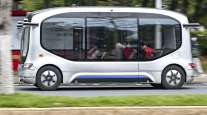When Self-Driving Vehicles Take to the Road, Impact on Jobs is Uncertain

Millions of Americans make a living by driving trucks, delivery vans, taxis and ride-hailing cars. When technology takes the wheel, what will happen to their livelihoods?
That question is growing more urgent as the advent of self-driving vehicles accelerates. Major players such as Ford Motor Co., Volvo and Tesla Motors have introduced concrete plans. In Singapore, autonomous taxis are on city streets, and Uber’s first fleet hits Pittsburgh this month.
Predictions range from apocalyptic warnings of major unemployment and economic collapse to utopian views of new job categories, increased efficiency and dramatic decreases in deaths and injuries from vehicle crashes.
Even Tesla CEO Elon Musk, whose company is pushing hard to develop autonomous vehicles, has warned that the technology could cost jobs.
“If you have self-driving cars, then what happens to the 12% of the population whose job it is to drive a car or drive a truck?” Musk said at a forum in May. Self-driving vehicles, he said, are just one example of how artificial intelligence could create a “tremendous upheaval in terms of employment.”
RELATED: ATA's Spear on Fox Business News: Autonomous trucks can improve job growth in sector
Uber CEO Travis Kalanick has taken positions on both sides. He infuriated drivers two years ago by saying at a tech conference that getting rid of “the other dude in the car” through driverless technology would make Uber rides cheaper. But last month, he told Business Insider that human-piloted Ubers still would be needed and predicted that autonomous cars would spawn new jobs such as fleet maintenance. Initially, Uber’s Pittsburgh cars will carry an engineer ready to take the wheel if needed.
Many ride-hailing drivers are dubious about their future but figure they will have time to devise a Plan B.
“Most drivers know [autonomous cars] are coming; it’s just a matter of when,” said Christian Perea, who drives part time for Uber and Lyft in San Francisco and writes for the Rideshare Guy blog. (Lyft also is pursuing driverless taxis through a partnership with General Motors. Co.) “But I don’t think it will be a situation where robots show up one day and clean house within five minutes. It will happen slowly enough for me and others to adapt and find other ways of earning money.”
The majority of Lyft and Uber drivers work part time, studies show. Many drivers already plan to transition to other work as spates of price cuts by Uber and Lyft have hurt their income, Perea said.
Edward Escobar, a San Francisco driver and founder of the Alliance for Independent Workers, an association of ride-service drivers and other contractors, takes a dim view.
RELATED: Trucking enters the age of automation
“Uber has Walmartized the process and brought on people to be like spokes in a wheel, replaceable, expendable,” he said. “Most drivers will get the short end of the stick” when autonomy happens. Meanwhile, he’s already looking ahead, diversifying the types of gigs he does.
Labor leader Andy Stern sees the biggest potential hit to America’s 3.5 million truck drivers. “Commercial truck driving is going to be the leading edge of a tsunami of labor displacement,” said Stern, former president of the Service Employees International Union. “It’s not something the next generation is going to have to deal with — it’s going to happen in the next decade.”
Truck drivers, he noted, support a vast web of workers whose own jobs may be imperiled.
“We’re talking millions of jobs: the drivers themselves, but also the people in insurance, repairs, restaurants, hotels,” Stern said. “I think it’s incredibly irresponsible that no one’s making plans for this.”
Of course, not everyone agrees that self-driving technology will render truckers and cabbies obsolete.
Many truck drivers themselves say they simply cannot envision being replaced by robots.
“Can a computer drive an 80,000-pound machine at 80 miles per hour?” asked Manuel Silveira, a 22-year industry veteran who drives a big rig between Oakdale in Stanislaus County and the Port of Oakland. He and several other drivers interviewed at the port last week said their top concern isn’t their work; it’s how safe the technology might be.
“Driving a truck is not a simple task,” said Gurmit Singh, an owner-operator based in Fresno. “We’re not going to sleep well [with autonomous vehicles on the road] unless they have special lanes on the highway. A machine will never be perfect.”
In fact, even the companies developing autonomous trucks say they will not supplant drivers.
German auto giant Daimler, the world’s leading truck manufacturer, which has been testing its own autonomous truck in Nevada, pitches its Inspiration Truck system as a way to maintain consistent speeds, stay in lanes and brake as needed. It has no plans to create trucks that can drive without human intervention, Derek Rotz, director of advanced engineering for Daimler Trucks North America, said in an e-mail.
In fact, he said, the technology could help attract younger drivers, who are badly needed in an industry that saw a shortage of 48,000 drivers in 2015, according to American Trucking Associations.
“Drivers are aging rapidly, are nearing retirement, and new recruits have not filled the void,” Rotz said. “Current trends show the shortage increasing in the coming years. Technology, including safety systems, autonomous systems and connectivity, would make trucks and truck driving as a profession more attractive to the next generation of drivers.”
Uber’s new acquisition, San Francisco startup Otto, which is developing a self-driving kit to retrofit existing trucks, says its trucks will always need a driver on board. Its plan is that they could catch some sleep while its system — a sort of super cruise control — handles freeway driving.
“We don’t think we’ll replace drivers,” said Eric Berdinis, Otto product lead. “There’s lots of complexity around loading, unloading, paperwork, weigh stations, police, refueling. To autonomate those aspects is not possible. We see this as a way to extend the amount of time truck drivers can drive safely.”
ATA President Chris Spear said some of the technologies being tested could offer major benefits to trucking companies and their drivers.
Vehicle-to-vehicle communication, which allows autonomous cars or trucks to signal each other on the road, could prevent accidents, he said. Systems that allow trucks to follow each other closely in a tight convoy — an idea called “platooning” already tried in Europe — could cut fuel use. He doubts that trucks could become fully driverless anytime soon.
“I keep telling our members, ‘We cannot be afraid of technology — it can solve more problems than it creates,’” Spear said. “If this technology can be a catalyst to getting to zero fatalities, we want to be part of that.”
Not everyone in the trucking business is so upbeat.
“There certainly is discussion among drivers,” said Todd Spencer, executive vice president of the Owner-Operator Independent Drivers Association. “They’re not naive enough to think that anyone would be pursuing this for any reason other than doing away with those jobs.”
And yet, like Spear, Spencer doubts that trucks will soon be able to run entire trips on their own, no human required. Navigating a big-rig through narrow city streets, he said, is much harder than staying in-lane on a quiet rural interstate. And even the open road may present challenges that sensors and algorithms can’t handle.
“When you’re on top of a 6,000- or 8,000-foot grade in the dead of winter, and it’s 10 degrees, and you’re just getting glimpses of the road … it requires the absolute best somebody has to get down that mountain without losing it,” said Spencer, a former driver. “That’s not a time that anyone wants to gamble with technology.”




